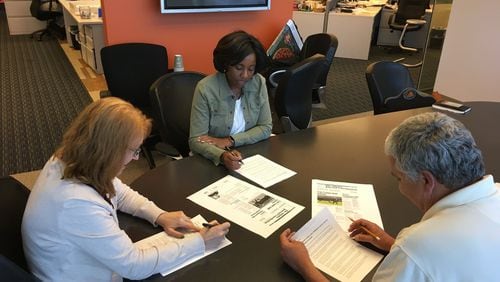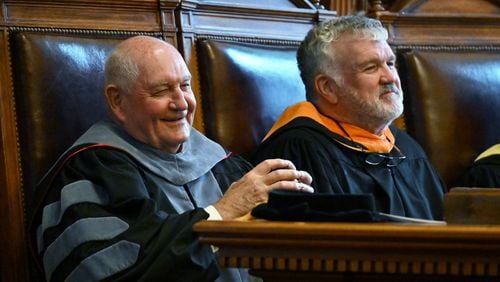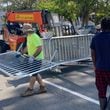What a week of news. A year of news for that matter.
I’ve been a newspaper journalist for more than half my life. My very first year in the business, Mikhail Gorbachev was beginning to lead the Soviet Union out of the Cold War, and an Exxon Valdez tanker spilled millions of gallons of crude oil off the Alaska coastline.
I was working as a copy editor at The State newspaper in Columbia, S.C. It hadn’t been long after I left Atlanta to head east across Interstate 20 that Hurricane Hugo tore through Charleston. That devastating storm left the state reeling with dozens of deaths and more than $6 billion in damage.
I remember the Iran-Contra scandal and working to make sense in my 20-something mind of all the talk of arms deals, Nicaraguan rebels and a man named Oliver North.
Over the past two decades, I’ve worked in newsrooms during some pretty big, breaking news events. I will never forget when Nelson Mandela was freed from a jail in South Africa or watching him cast his vote for himself as president almost four years later. I was in the newsroom in St. Petersburg, Fla., the evening O.J. Simpson led California police on a low-speed chase in his Ford Bronco and stood with shell-shocked journalists when jurors later acquitted him of murdering his ex-wife.
Most of the time, when I remember major news events – the Space Shuttle Columbia disaster, the September 11th terrorist attacks, the Oklahoma City bombing, the election of President Barack Obama, the election of President Donald Trump — I remember it as a working journalist, not a regular citizen.
As a journalist, you develop a special appreciation for breaking news and its ability to disrupt your life not only professionally, but personally as well. As other people hunker down at home during storms or other threats, you run toward it – sometimes literally. No, there's no such thing as snow day for me.
Our job is to help readers understand what’s happening from an objective standpoint that has proper context, and balanced, fair and accurate information. Oh, and the news has to be up-to-date and timely. Timely is a complicated word in today’s print newspaper. Online, of course, it is much easier. In a matter of seconds you can update a story, fix an error, or even kill a story. In the printed edition, if something happens past deadline, things become a little more complicated.
We’re learning now more than ever that complicated isn’t just events that are past deadline, it’s also events on deadline, or is there any such thing as deadlines anymore? For years, printed newspapers had deadlines throughout the day for stories, photos, graphics, pages, headlines and proofing. We’re usually a stickler for making deadline so that when readers walk out their door in the morning, the newspaper is already in their driveway.
I’m one of the those old-school readers who still enjoys opening the paper in the morning, turning the pages of all the sections and keeping papers for days so that I can catch up on what I missed. Still throughout the day, I’m reading what’s online from various sources. I have several news apps that ping me all day long with breaking news alerts.
I’ve gotten a lot of alerts this week, this month, this year.
Editors and reporters spend much of their day planning, reporting, writing, updating. It’s our hope that by late evening, we have a good sense for the news of the day. By the end of the workday, our Page 1 editor has listened to story pitches, consulted with various editors, reviewed photos and put together a solid plan for the front page you’ll have the next morning.
It’s at that point that two to four editors huddle together to read drafts or final versions of stories making it onto the front page so that we can write headlines for those stories. It’s a team effort where we nix, push, contemplate, challenge and encourage one another in our quest to write the best headline. Sometimes, best is straight to the point and boring. Other times, best is clever and powerful. Almost daily this week, we’ve gone through this ritual only to look up at the television monitor late in the evening to see that some big story was unfolding in Washington.
Over the years, we’ve grown accustomed to this happening every once and a while, and it’s actually pretty exciting when it happens. Now, our new normal is to expect that we’ll rip up the page and start over almost every single day. Page 1 editor Laura Weaver jokes that she spends all day planning for that 10 minutes late in the day when she’ll simply start over.
I know readers have their own ideas about what we do and how we do it. While it’s not as glamorous as what happens in the movies or on TV, it’s not as calculated either. We do our best to honor the news and the impact it has on the lives of readers and the general public. We don’t take it lightly, whether it’s a photo, a story or headline. One of our top editors likes to say the printed paper is the biblical version of the news.
“Everyone gets news from a lot of sources throughout the day – TV, radio, websites, phone alerts,” says Weaver, our senior editor for print. “The more closely you follow it, the more exhausting and confusing it becomes. But we take the noise of the day and try to bring it together into one coherent story.”
That doesn’t mean that we’re perfect. But we do try to get it right, and when we don’t, we try to acknowledge that. Yes, sometimes we make the wrong call. Sometimes, we simply run out of time.
Thanks to an evolving online world, social media and how readers and our leaders give and get information, we continue to embrace the disruption in order to serve you – daily, weekly, monthly and yearly.
About the Author






